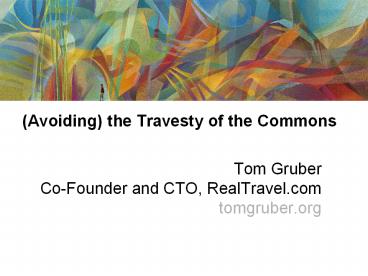(Avoiding) the Travesty of the Commons PowerPoint PPT Presentation
Title: (Avoiding) the Travesty of the Commons
1
(Avoiding) the Travesty of the Commons
- Tom GruberCo-Founder and CTO, RealTravel.comtomg
ruber.org
2
The Promise of the People-Powered Web
- More people know more things.
- More people have more diverse perspectives and
assumptions. - Collectively we can know more.
- But...
- When is More Better?
- If you build it, will they come?
3
Everybodys Doing It
- over a third of adults in US and Australia have
contributed content to the public Internet - 100M blogs
- 100GZ photos
source http//www.futureexploration.net/fom06/Futu
re_of_Media_Report2006.pdf
4
Web Content Creation by Age
18 of adults over 65 have contributed content to
the web
source http//www.futureexploration.net/fom06/Futu
re_of_Media_Report2006.pdf
5
The Influence of Collective Knowledge
source http//alexa.com
6
The Influence of Collective Knowledge
logo source http//wikipedia.com
7
Same Technology
http//flickr.com/photos/fuzheado/21039745/
8
Different Result
http//flickr.com/photos/ross/20509165/
9
Same People, Same Technology
noise
creation
source http//istockphoto.com
10
Collective Knowledge is Real
- FAQ-o-Sphere (self service QA forums)
- A-list Blogosphere for politics and tech
- Product reviews for gadgets and hotels
- Amateur Academia
- Collaborative filtering for books and music
- Social photo sharing
11
...and can be a real pain
- IP looting in music
- Automated blog spam
- Marketplace of fraudulent reviews
12
The Art and Science of Collective Knowledge
- Timing, luck, and vision are critical, but...
- ClaimDesign principles can influence the result.
13
Case Study RealTravel
- When planning travel, people want to benefit from
experience of people who have been there. - Lets do this on a global scale.
14
Problem 1 Motivating Participation
- Why should I share my feedback and advice about
my travel experience with strangers? - So I can share it with friends and family.
- With style.
15
(No Transcript)
16
(No Transcript)
17
(No Transcript)
18
(No Transcript)
19
(No Transcript)
20
(No Transcript)
21
(No Transcript)
22
(No Transcript)
23
(No Transcript)
24
Principle of motivationEnlightened Self Interest
- Design services that reward individual behavior
that has global benefit. - Communicate the value proposition to people who
would recognize that value.
25
MotivatorsWhat Powers People-Powered
- entertainment value of participation
- social connection
- ego / ambition
- altruism
- Design for these motivators.
- Target audiences with these motivators.
26
De-motivators
- Awkward or time-consuming UI
- Nontrivial learning curve
- except for games
- Lack of positive feedback for desired behavior.
- Design to avoid these de-motivators.
- Target audiences who dont mind.
27
Problem 2 How to reach the right people?
- Participants are not necessarily the same
population as those who benefit from their
contributions. - Participants are motivated differently
- Travel bloggers care about trips.
- Travel researchers care about destinations.
- Design user experiences for targeted audiences.
28
Growth Phases of Social Sites
29
Viral is not the only way
- OurStory is a place for sharing life stories
- Targeted marketing campaign to grow participant
base
6 weeks
source Andy Halliday, CEO OurStory, personal
communication
30
Problem 3 How to Harvest Value
- Value of aggregate must be much greater than sum
of parts - need value for both contributors and learners
- Quality metrics of aggregate content are
different than for individuals - Completeness/coverage matters
- Need best first criteria
- Bad apples can spoil the batch
31
Creating Aggregrate ValueMash-up with
structured data
- Backbone of Web 2.0 offering is competence in
domain-specific data - see OReiily paper
- The aggregate site creates unique value by
tightly integrating user contributions of
understructured content with centrally managed
structured data.
ref http//www.oreillynet.com/pub/a/oreilly/tim/n
ews/2005/09/30/what-is-web-20.html
32
UI Technique Pivot Browsing
- RealTravel manages an authoritative central
database of destinations (places). - Contributors place their content into the
destination hierarchy. - The combination offers travel researchers
powerful browsing and search capabilities.
33
(No Transcript)
34
(No Transcript)
35
(No Transcript)
36
(No Transcript)
37
(No Transcript)
38
(No Transcript)
39
(No Transcript)
40
Contextual Tagging
- Tags are bottom up labels, words without context.
- A structured data framework provides context.
- Combining context and tags creates insightful
slices through the aggregate content.
41
(No Transcript)
42
(No Transcript)
43
(No Transcript)
44
Problem 4 Guiding Behavior
- Question Why should a user do something for the
benefit of the community? - Answer Wrong question.
- Approach Reduce friction of useful behavior.
45
UI Technique Snap to Grid
- Observation Left to their own, users wont
produce a consistent database. - Technique Elicit their data in the context of
structured data let them snap to grid. - Inherit structure data to the unstructured
contribution provide value from the grid.
46
(No Transcript)
47
(No Transcript)
48
(No Transcript)
49
(No Transcript)
50
(No Transcript)
51
Group Discussion Techniques of Design for
Participation
- Motivating participation
- answer faqs in the context of the wiki
- connecting it to the social group that exist
- competitiveness score keeping
- Reaching targeted audiences
- Harvesting value
- Guiding behavior toward global benefit
- make it easy to upload and share itinerary
52
Thank You
Tom Grubertom_at_realtravel.com RealTravel.com tomgr
uber.org

